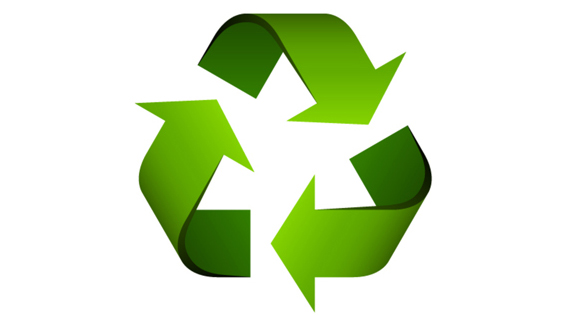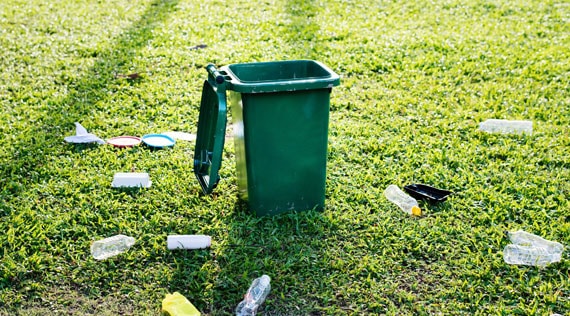On a rainy Friday in early November, Emily LeMay sat behind the wheel of her county-issued SUV and looked out onto a heaping pile of garbage waiting to be processed at the Pinellas County Solid Waste facility.
Mixed into the mounds of trash were yard clippings, soiled towels, old toothbrushes and other remnants of distinguishable household waste that had made its way to the facility to be burned and then packed into the nearby landfill.
But there were also items that didn’t belong.
Plastic bottles that once held milk or laundry detergent. Dirty cans. Boxes.
“So much cardboard,” LeMay said, eyes wide, a slight shake to her head.
LeMay, who coordinates recycling and outreach for the county’s solid waste department, said that about a third of the garbage the facility receives are items that could have been recycled.
As waste and consumption increase during the holiday season — the Environmental Protection Agency estimates that household waste increases by more than 25 percent nationwide between Thanksgiving and New Year’s Day — LeMay said it’s especially important to get into the habit of practicing proper disposal techniques.
“If you already recycle, it’s time to revisit the rules for your local center to make sure you know what it accepts,” LeMay said.
And if you aren’t already recycling?
“Now’s a great time to start,” LeMay said.
Here’s a quick refresher on what does — and doesn’t — go into the recycling bin, and other resources available to help you minimize waste while you ring in the holidays around Tampa Bay.
‘Wishful recycling’ does more harm than good
Recycling is important. But if you’re putting items in the bin that aren’t accepted at the plant, that does more harm than good.
In Pinellas, LeMay said that residents can defer to the “where does it go” search tool on the county website. When you enter the name of an item you’re looking to get rid of, the system returns instructions about how to dispose of it.
The tool can be used to look up anything from electronics to mattresses to nail polish. It even includes instructions for getting rid of a piano.
An aluminum pie tray? Put it in the garbage.
A frying pan? Here’s a list of scrap metal collection sites.
The newspaper you’re reading? Place it in the recycling bin.
“People can search any item they can think of and we’ll give them detailed instructions for how to get rid of it, whether it’s recycling or a specialty program, or if it just goes in the trash,” LeMay said. “Knowing your options is really important.”
Reduce and reuse
The best way to minimize your garbage footprint is to simply reduce the amount of waste you create.
If you’re shopping for groceries this Thanksgiving, bring reusable bags to the store and avoid using individual plastic bags when selecting produce. Don’t buy more than you need, and when you’re serving up your feast, try to use plates and trays that you can wash, rather than those you’ll throw out.
“Recycling helps, but ultimately we want to create as little waste as possible,” LeMay said.
Stephanie Watson, who also runs recycling programs for Pinellas County, said that efforts to reduce waste don’t have to stop at the dinner table.
Estimates from the National Retail Federation show that holiday sales could break records this year. But Watson wants to challenge residents to think outside the box — literally.
She said rather than buying new items from retailers, consider gifting experiences this holiday season — think concert tickets, a special meal, or a year-round pass to a local park or museum.
And on the receiving end, if you’re happy to be gifted items from thrift stores or consignment shops, be sure to communicate that to your loved ones.
“Sometimes there’s a stigma to buying things that have been previously loved,” Watson said. “It’s helpful if you let people know that you’re open to gently used gifts.”
If you have clothes, toys or household goods that you’re no longer using, take them to a donation center or trade them in at a consignment shop, rather than tossing to the curb, Watson said. It’s a good time to do your annual closet cleanout — what you’re no longer using could be just what somebody else is looking for.
“People are well-intentioned, they want to recycle as much as they can,” said Travis Barnes, who heads the program for Hillsborough County. “When there’s an item in question, people often err on the side of, ‘Oh, they’ll just figure it out at the plant, we’ll put it in there just in case.’ ”
Barnes called that “wishful recycling,” and he said it’s detrimental to the program.
Common culprits, he said, are things like plastic silverware and plates, bubble wraps, packing materials and styrofoam.
The worst are what he called “tanglers” — plastic bags, holiday lights, or anything that could get caught in the rotating machinery that sorts recyclables at the plant.
Barnes said tanglers damage equipment and can shut down operations when they get stuck. It’s costly, and it’s dangerous for workers who have to climb out onto the equipment and manually cut out the materials that are causing the break.
“What we tell people is when in doubt, leave it out,” Barnes said.
Knowing your options
Most recycling centers are set up to receive traditional materials: plastic bottles and containers that you could rinse out and reuse at your home, aluminum cans and plastic or glass jars, dry paper and flattened cardboard.
But Barnes said that each recycling center is set up a little bit differently, and a quick Google search can provide you with a refresher on the rules of your specific processing center.
Courtesy : https://www.tampabay.com/news/environment/2021/11/23/the-holi-dos-and-donts-of-recycling/

